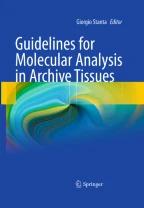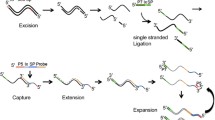
This chapter provides a procedure and some advice for direct sequencing of PCR products from DNA extracted from formalin fixed and paraffin embedded (FFPE) tissues. A section in detail is dedicated to the analysis of the electropherograms. Generally, mutational analysis requires the extraction of DNA from FFPE, PCR amplification and PCR product purification and sequencing. The chapter is dedicated particularly to the analysis of somatic mutations in tumour tissues specifying the importance of analyzing a limited amount of non-mutated DNA component in order to obtain good quality and analyzable electropherograms.
This is a preview of subscription content, log in via an institution to check access.
eBook EUR 96.29 Price includes VAT (France)
Softcover Book EUR 126.59 Price includes VAT (France)
Tax calculation will be finalised at checkout
Purchases are for personal use only

Artifacts are ex novo sequence alterations introduced by the Taq polymerase during the PCR reaction that become visible in the electropherogram when the enzyme amplifies a single strand of damaged DNA. This situation appears when few nanograms of DNA template are used (i.e. 10 ng or less) or when DNA template has high degradation levels (such as DNA from formalin-fixed samples). The expected frequency of artifacts can be considered around 1/4,000 in fresh frozen samples and 1/1,000 bp in formalin fixed samples
There are commercial PCR premixed solutions for convenient PCR setup, containing PCR buffer and dNTPs. Usually Taq Polymerase is provided with its dedicated 10x buffer. Check the composition for the presence of MgCl2. Different commercial PCR buffers are MgCl2 free but a 25 mM or 50 mM MgCl2 solution is supplied with buffer and enzyme. MgCl2 content could be incremented in cases of multiplex PCR or decremented in cases of high fidelity PCR
Primer design could be performed using specific software, please refer to http://molbiol-tools.ca/PCR.htm for the on line available software. Since the first 20–40 bases of the electropherograms are not usually reliable, it is necessary to design primers that match about 40–50 bases before the region of interest
Primer design depends on the quality of starting material. For sub-optimal quality of material (for example DNA from FFPE), shorter PCR products are recommended. However, using higher amounts of starting DNA, the probability to have some intact template molecule is higher and products up to 400 bp can be obtained from FFPE or even longer from alcoholic fixatives. When working with highly damaged DNA, we suggest designing primers for amplicons of around 150 base pairs even if it would cover a short region of interest
In the case of cDNA sequencing, see chapters “RNA Extraction from FFPE Tissues”, “DNase treatment of RNA” and “Reverse Transcription (RT), then use the obtained cDNA to proceed with PCR. Use 120 ng of cDNA as template for PCR. If necessary, increase up to 200 ng for difficult amplifications. Primers for cDNA amplification should be intron skipping in order to avoid genomic DNA amplification
In the analysis of tumour associated mutations, the selected region of the tissue slide should not contain more than 20–30% of normal cells in order to obtain a reliable result in the sequencing analysis. In particular, consider the contamination from lymphocytes infiltrating the tumour
A very accurate quantification of DNA solution is recommended because the PCR for the sequencing analysis requires proper DNA template amounts. When a very little amount of DNA is expected, quantification with a Nanodrop spectrophotometer is recommended because it allows a reliable quantification using only 1 μl of sample
In order to prevent further degradation, whatever the source of the extracted DNA, multiple DNA freezing and thawing should be avoided. For this reason, after quantification, the concentrated DNA sample should be divided into aliquots suitable for the following PCR amplification. The dilutions can be stored at 4°C for a short time (3–4 weeks). The quantification of the concentrated DNA solution should be repeated after each thawing
It is important to reduce the primers to optimal concentration because an excess could result in primer dimers formation and thus interfere with sequencing giving a higher background in the electropherograms
Lowering the amount of Taq polymerase can reduce the presence of aspecific products Amplifying nanograms of target DNA is troublesome with smaller volumesA good suggestion is to start with 5–20 ng of DNA template (usually the high DNA degradation caused by formalin does not allow amplifying less than 5 ng). If no PCR products are obtained, try to increase the quantity (do not exceed 500 ng; in case design primers for shorter amplicons)
Freeze-thawing of the PCR products causes their degradation and consequently result in electropherograms with high background. For this reason, it is suggested to store the amplified DNA at 4°C. However, if the PCR products have been frozen repeatedly, good sequencing results may be still obtained by using a higher amount of PCR product (50–100 ng) in the sequencing reaction without changing the amount of primers
Do not confuse polyacrylamide artifacts with aspecific products: the former consist in thin and weak bands of high molecular weight (far more than 1 kbp) and do not interfere with the sequencing reaction
Since the DNA is highly diluted, this step is necessary to allow an accurate spectrophotometric DNA quantification
The Dehydration step can be performed at 60°C in a thermoblock with open tube capsThe probability that the artifacts detected in the first round of PCR appear in a second independent PCR amplification is extremely low
On-line free software, such as “ClustalW” (www.ebi.ac.uk/Tools/clustalw2/index.html) can be used to perform the alignment